What Is The Largest Land Animal In The Western Hemisphere Is The What? |quizlet
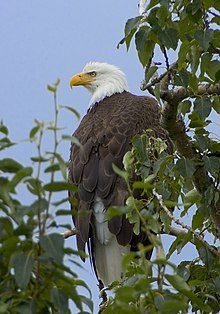
The fauna of the U.s.a. is all the animals living in the Continental United States and its surrounding seas and islands, the Hawaiian Archipelago, Alaska in the Arctic, and several island-territories in the Pacific and in the Caribbean. The U.South. has many endemic species found nowhere else on Earth. With most of the Northward American continent, the U.S. lies in the Nearctic, Neotropic, and Oceanic faunistic realms, and shares a great deal of its flora and fauna with the residuum of the American supercontinent.[i]
An estimated 432 species of mammals characterize the fauna of the continental U.Due south. There are more than 800 species of bird[2] and more than than 100,000 known species of insects.[3] There are 311 known reptiles, 295 amphibians and 1154 known fish species in the U.S.[4] Known animals that exist in all of the lower 48 states include white-tailed deer, bobcat, raccoon, muskrat, striped skunk, befouled owl, American mink, American beaver, Due north American river otter and red fox. The red-tailed hawk is one of the most widely distributed hawks not only in the U.Due south., but in the Americas.
Huge parts of the land with the most distinctive indigenous wildlife are protected as national parks. In 2013, the U.Southward. had more than 6770 national parks or protected areas, all together more than than 1,006,619 sq. miles (2,607,131 km2).[5] The first national park was Yellowstone National Park in the state of Wyoming, established in 1872. Yellowstone National Park is widely considered to be the finest megafauna wildlife habitat in the U.S. There are 67 species of mammals in the park, including the gray wolf, the threatened lynx, and the grizzly comport.[6]
Western United States [edit]
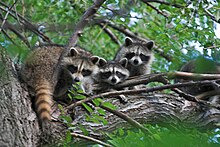

The ecoregions and environmental institute in the Western United States are extremely varied. For instance, large areas of state are made up of everything from sand dunes in the Central Bowl and Range ecoregion, which makes up much of the Country of Nevada, to the ecology of the N Cascades in Washington state, which has the largest concentration of agile alpine glaciers in the Lower 48'due south. The densely forested areas found in Northern California, Oregon, Washington, Idaho, and Montana have mostly species adapted to living in temperate climates, while Southern California, Nevada, Arizona, southern Utah, and New United mexican states have a animate being resembling its position in the dry deserts with temperature extremes.
The western continental coast of the U.Southward., just every bit the East Coast, varies from a colder-to-warmer climate from n to south. Few species alive throughout the entire West Coast, however, at that place are some, including the bald eagle that inhabits both the Alaskan Aleutian Islands and the California Channel Islands. In most of the contiguous Western U.S. are mule deer, white-tailed antelope squirrels, cougars, American badgers, coyotes, hawks and several species of snakes and lizards are common.
While the American black carry lives throughout the U.Southward., the dark-brown bears and grizzly bears are more than common in the northwest and in Alaska. Along the West Coast there are several species of whales, body of water otters, California sea lions, eared seals and northern elephant seals. In the dry, inland desert areas of states such every bit California, Nevada, Arizona and New Mexico in that location are some of the globe's about venomous lizards, snakes and scorpions. The most notorious might be the Gila monster and Mohave rattlesnake, both found in deserts in the Southwest. The Sonoran Desert has eleven species of rattlesnakes - more than anywhere else in the world.[seven]
Forth the southwestern border there are jaguars and ocelots. Other mammals include the Virginia opossum, which occurs throughout California and coastal areas in Oregon and Washington. The North American beaver and mountain beaver alive in forested areas of Washington, Oregon and Northern California. The kit fox lives throughout Arizona, New Mexico and Utah, while the gray flim-flam occurs throughout the Western U.S.
The red trick occurs more often than not in Oregon and Washington, while the island fox is a native to half dozen of the eight Channel Islands in Southern California. These islands are also famous for their marine life and endemic species such equally the Channel Islands spotted skunk, Garibaldi, isle fence lizard, island scrub jay, baldheaded eagle, and their non-native Catalina Island bison herd. The raccoon and spotted skunk occur throughout the Western U.Southward., while the ring-tailed cat occurs throughout Arizona, New United mexican states, Western Texas, Utah, Colorado, and most of California. The American black bear occurs in most western states, including Washington, Oregon, California, Arizona and Colorado.
Channel Islands [edit]
The Channel Islands National Park consists of five out of the eight California Channel Islands. The Channel Islands are part of one of the richest marine biospheres of the earth. Many unique species of plants and animals are endemic to the Aqueduct Islands, including fauna such every bit the island play tricks, Channel Islands spotted skunk, island scrub jay, ashy storm-petrel, island argue cadger, island night lizard, Aqueduct Islands slender salamander, Santa Cruz sheep, San Clemente loggerhead shrike and San Clemente sage sparrow.[8] Other animals in the islands include the California sea lion, California moray, baldheaded eagle, Channel Islands spotted skunk and the non-native Catalina Isle bison herd.
Southern Us [edit]
The South has a large multifariousness of habitats that range from the Mississippi River basin in Arkansas and Mississippi to the Southern Appalachian Mountains. As far northward as the hills of Tennessee and Virginia, all the fashion down to the Everglades in the southern end of Florida. From the eastern-almost point on the Outer Banks of North Carolina, as far west equally the deserts and prairies of West Texas and Oklahoma. The warmer climate allows for rich biodiversity ranging from cypress swamps in Louisiana to the thick bays and the longleaf pine biome of the South Carolina Lowcountry. Information technology is riddled forth the way with countless salt marshes in every coastal state from the Carolinas, through Georgia to Texas, including the Mobile Delta that lies in the borders of Alabama.

The Southern United States is home to a multitude of reptiles and amphibians. The American alligator lives in much of the South - including every littoral state from North Carolina to Texas, along with the inland states of Arkansas and Tennessee- while the less widespread American crocodile is only constitute in southern Florida. The Alligator snapping turtle and more forty other species of turtle are found in the of the southern U.S. including the eastern box turtle, red-eared slider, and the softshell turtle. Snakes in the region include the eastern copperhead, eastern diamondback rattlesnake, timber rattlesnake, pigmy rattlesnake, cottonmouth, and eastern coral snake, all of which are venomous. Some of the other reptiles and amphibians thriving in the South include the Carolina anole, razor-backed musk turtle, broad-headed skink, American bullfrog, southern toad, leap peeper and the coal skink.
Mammals of the region include the elk, the largest of which that was wiped out in the 1800s, but has been reintroduced and is making promising recoveries in Virginia, North Carolina, Tennessee, and Arkansas. At that place still remain resident populations in parts of Texas and Oklahoma. The American black comport is native to much of the S, merely are prevalent in Virginia, the Carolinas, Tennessee, Georgia, Florida, Arkansas, and Oklahoma. The Florida panther is the largest feline in the South and is exclusive to the wetlands of South Florida. White-tailed deer, bobcat, coyote, wild boar, red and grey fob are other mammals that inhabit parts of every country in the region. Wild horses roam parts of the South in pocket-sized groups, which are remnants of horses brought by settlers in the 1400s and 1500s. These are mostly in coastal habitats.
Many water-dwelling mammals inhabit the South including the American beaver, muskrat, river otter, and nutria, which is an invasive species and has decimated plant life in the swamps of Louisiana. Weasels and mink also adopt being near water. Rabbits are common in the South; the eastern cottontail is institute throughout the region, while the desert cottontail and black-tailed jackrabbit is primarily plant in Texas, and Oklahoma. The swamp rabbit is found in wetlands of states like Mississippi, Alabama, Louisiana and Arkansas, while the marsh rabbit resides along the littoral regions of the Carolinas, Georgia, Florida, and Alabama. Squirrels are also abundant. The eastern grey squirrel and eastern pull a fast one on squirrel tin both be found in every southern country. The southern range of the American carmine squirrel dips into the college elevations of Virginia and Due north Carolina. Other mutual mammals are the Virginia opossum, raccoon striped and spotted skunk, groundhog and in parts of the South, the nine-banded armadillo.
There are over 1,100 species of bird in the Southern U.South. ranging from upland birds, to waterfowl. The South is home to many littoral birds including gulls, track, gallinules, skimmers, grebes, sandpipers, cranes, and herons. Upland birds include wild turkey and ruffed grouse. Diverse game bird species such as the bobwhite quail and the woodcock. The eastern whip-poor-will and the Chuck-volition's-widow belong to the nighthawk family unit and are found in every southern land. Songbirds make upward the largest portion of birds found in this region.
Central United States [edit]
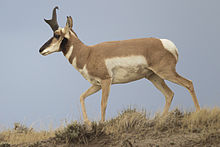
The pronghorn is the fastest country mammal in the Western Hemisphere and can reach speeds up to 55 mph.[9]
In the prairie in the Central The states lives mostly animals adjusted for living in grasslands. Indigenous mammals include the American bison, eastern cottontail, black-tailed jackrabbit, plains coyote, blackness-tailed prairie canis familiaris, muskrat, opossum, raccoon, prairie chicken, wild turkey, white-tailed deer, swift foxes, pronghorn antelope, the Franklin's ground squirrel and several other species of ground squirrels.
Reptiles include bullsnakes, common collared cadger, common snapping turtle, musk turtles, yellow mud turtle, painted turtle, western diamondback rattlesnake and the prairie rattlesnake. Some of the typical amphibians found in the region are the three-toed amphiuma, green toad, Oklahoma salamander, lesser siren and the plains spadefoot toad. In the Rocky Mountains and other mountainous areas of the inland is where the bald eagle is most observed, even though its habitat includes all of the Lower 48, every bit well as Alaska.
Rabbits live throughout the Dandy Plains and neighboring areas; the blackness-tailed jackrabbit is plant in Texas, Oklahoma, Nebraska and Kansas, the white-tailed jackrabbit in the Dakotas, Minnesota and Wisconsin, the swamp rabbit in swampland in Texas, and the eastern cottontail is constitute in Texas, Oklahoma, Kansas, Nebraska, the Dakotas, and every state in the Eastern U.S.

The groundhog is a mutual species in Iowa, Missouri, and eastern portions of Kansas, Nebraska and Oklahoma.
The groundhog is widespread throughout Illinois, Iowa, Missouri, and Minnesota. Virginia opossum is found is states such as Missouri, Indiana, Iowa, Oklahoma, Nebraska and Kansas.
The nine-banded armadillo is found throughout the South and states such as Missouri, Kansas and Oklahoma. The muskrat is found throughout the Central U.S., excluding Texas, while the American beaver is establish in every cardinal land.

The American bison is the heaviest land animal in North America and can be as tall as 6.5 feet (two.0 m) and weigh over a ton.[10]
Maybe the most iconic creature of the American prairie, the American buffalo, once roamed throughout the central plains. Bison once covered the Keen Plains and were critically important to Native-American societies in the Central U.South. They became nearly extinct in the 19th century, but have made a contempo resurgence in the Nifty Plains. Today, bison numbers have rebounded to almost 200,000; these bison live on preserves and ranches.[ten]
Some of the species that occupy every key state include the red fox, bobcat, white-tailed deer, raccoon, eastern spotted skunk, striped skunk, long-tailed weasel, and the American annoy and beaver. The wild boar is common in the South, while the American mink lives in every cardinal state with the exception of Texas. The least weasel is institute effectually the Great Lakes likewise as states such as Nebraska, the Dakotas, Minnesota, Iowa, Illinois, Michigan, and Wisconsin.
The grayness trick is found in Iowa, Missouri, Oklahoma, Texas and also around the Great Lakes region. The ring-tailed true cat is found in the southern region, including in Texas, Missouri, and Oklahoma. There are many species of squirrels in the central parts of the U.S., including the fox squirrel, eastern greyness squirrel, Franklin'south footing squirrel, southern flight squirrel, and the 13-lined ground squirrel. Voles include the prairie vole, woodland vole and the meadow vole. The plains pocket gopher lives throughout the Great Plains. Shrews include the cinereus shrew, southeastern shrew, Northward American least shrew, and the Elliot's short-tailed shrew.
Eastern The states [edit]
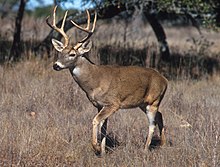
In the Appalachian Mountains and the Eastern U.s.a. are many animals that live in forested habitats. They include deer, rabbits, rodents, squirrels, hares, woodpeckers, owls, foxes and bears. The New England region is particularly famous for its crab and the American lobster living along nearly of the Atlantic Coast. The bobcat, raccoon and striped skunk live in every eastern country, while the American alligator lives in every coastal state between Northward Carolina and Texas.
Some species of mammals found throughout the Eastern U.S. includes the ruby flim-flam and grayness fox, the North American beaver, North American porcupine, Virginia opossum, eastern mole, coyote, white-tailed deer, American mink, North American river otter, and long-tailed weasel. The American black deport lives throughout near of New England, New York, New Jersey, Pennsylvania, Maryland, the Virginias, and parts of the Carolinas and Florida.

The American beaver is found throughout the U.S., except for Florida, Nevada and Hawaii.
Shrews are common: the cinereus shrew, long-tailed shrew and American water shrew are widespread in the New England region, while the North American to the lowest degree shrew and southeastern shrew are common in the southeastern states. The American pygmy shrew, smoky shrew, and northern short-tailed shrew are found from the Appalachian Mountains to New England. The star-nosed mole lives throughout the Eastern U.South., while the hairy-tailed mole is more mutual from the Appalachians to New England in the north.
Hares are likewise common: the snowshoe hare thrives from the Appalachians to New England, the Appalachian cottontail is merely found in the Appalachians, the New England cottontail is only found in New England, while the eastern cottontail is widespread throughout the east. While the white-footed mouse and muskrat are common throughout the east, with the exception of Florida, the meadow vole is plant from the Appalachians to New England and the southern cherry-red-backed vole is found in New England.[11] [12]

The brown rat and the firm mouse were both introduced and their habitat range throughout the Eastern U.South. Weasels such as the fisher and short-tailed weasel are establish in the northeast. The eastern chipmunk, pull a fast one on squirrel, eastern gray squirrel and the woodchuck are found throughout the region, while the southern flying squirrel and northern flying squirrel are more common in the southeast, the American red squirrel is more common in the northeast. The least weasel is native to the Appalachian Mountains.[11] [12]
The wild boar is the wild antecedent of the domestic pig and has spread through much of the southeastern region as an invasive species. The Canada lynx is found in parts of New England. Species of bats found throughout the e includes the eastern pipistrelle, silverish-haired bat, eastern red bat, hoary bat, big brownish bat, piffling brown bat, northern long-eared myotis, and in most regions the eastern small-footed myotis, grey bat and Indiana bat.[11] [12]
Of the marine life, the harbor seal is the nigh widely distributed species of seal and establish along the east coast, while the hooded seal, disguised seal, grey seal, ringed seal, and harp seal are found in the northwest. Whales are common forth Atlantic coastline. Whale species found forth the unabridged coastline includes the Gervais' beaked whale, common minke whale, fin whale, sei whale, bluish whale, humpback whale, sperm whale, dwarf sperm whale, pygmy sperm whale, killer whale, Cuvier's beaked whale, True'southward beaked whale, and the Blainville'due south beaked whale.[11] [12]
The northern bottlenose whale and the long-finned pilot whale are also common along the New England coast. Dolphins are common; species found along the entire coastline includes the Risso'due south dolphin, short-beaked common dolphin, striped dolphin, Atlantic spotted dolphin and the common bottlenose dolphin. Dolphin species institute in New England include white-beaked dolphin and Atlantic white-sided dolphin, while species roaming the southeastern parts of the coastline include the Fraser'south dolphin, pantropical spotted dolphin, Clymene dolphin, spinner dolphin, and the rough-toothed dolphin.[xi] [12]
Several sea turtles live along the Atlantic coast, including the hawksbill sea turtle, Kemp's ridley sea turtle, and loggerhead sea turtle. The dark-green bounding main turtle and leatherback sea turtle are more mutual species along the southeastern coastline. Land turtles and tortoises found throughout most of the Eastern United States are the common snapping turtle, painted turtle, spotted turtle, diamondback terrapin, spiny softshell turtle, eastern mud turtle, northern blood-red-bellied cooter, common musk turtle, eastern box turtle, and the yellow- and cerise-eared slider. While mutual species in the northeast include Blanding'south turtle, wood turtle, and bog turtle, mutual species in the southeastern U.S. include gopher tortoise, pond slider, Escambia map turtle, Barbour'south map turtle, eastern river cooter, striped mud turtle, loggerhead musk turtle, and the Florida softshell turtle. The polish softshell turtle is for instance found in the Ohio River and the Allegheny River in Pennsylvania.
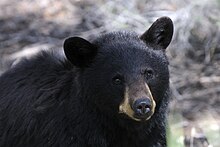
Some of the snake species found in much of the Eastern U.S. includes the eastern racer, De Kay's snake, northern copperhead, ringneck ophidian, timber rattlesnake, eastern pig-nosed serpent, milk serpent, northern water snake, western rat snake, northern redbelly ophidian, plainbelly water ophidian, midland water ophidian, ruddy kingsnake, mutual kingsnake, queen snake, smoothen earth ophidian, ribbon snake, and the common garter ophidian. Ophidian species mostly found in the northeast includes the smooth light-green snake, northern ribbon snake, and the eastern worm snake.
Snakes limited to the southeast includes the southeastern crown snake, pinesnake, eastern diamondback rattlesnake, coral ophidian, pygmy rattlesnake, southern copperhead, water moccasin, eastern coral snake, eastern indigo ophidian, southern hognose snake, coachwhip ophidian, banded h2o snake, dark-brown water snake, green water snake, Nerodia clarkii clarkii, salt marsh ophidian, mole kingsnake, pine woods snake, glossy crayfish snake, striped crayfish snake, short-tailed snake, swamp snake, rim rock crown serpent, rough world snake, southern blackness racer, rough dark-green snake, western rat snake, eel moccasin, and the mud and corn snakes. The eastern fence lizard is common throughout the Eastern United states, with the exception of New York and New England.
The grayness wolf once roamed the Eastern U.Southward., but is now extinct from this region. The eastern cougar as well was in one case as widespread as the cougar in the western parts of the country, but was accounted extinct past the U.S. Fish and Wild fauna Service in 2011.[13] Eastern elk once lived throughout the east, but was extirpated in the 19th century and declared as extinct past the U.Southward. Fish and Wild animals Service in 1880.[14] Moose as well one time roamed throughout the east, but is currently only constitute in northern New England. Due to its highly prized fur, the sea mink was hunted to extinction in 1903.[15]
Hawaiian Islands [edit]

Much of the fauna in Hawaii has developed special adaptations to their dwelling and evolved into new species. Today, nearly 90% percent of the fauna in Hawaii are endemic, pregnant that they exist nowhere else on Globe.[16] Kauaʻi is home to the largest number of tropical birds, every bit it is the only island free of mongooses. The Javan mongoose is widespread throughout the archipelago, except on the islands of Lanaʻi and Kauaʻi.
Famous birds include ʻiʻiwi, nukupuʻu, Kauaʻi ʻamakihi and ʻōʻū. Unfortunaly, most of these birds and at present extinct. The hoary bat is found in the Kōkeʻe State Park on Kauaʻi, wild horses live in the Waipio Valley, wild cattle by the Mauna Kea and the Australian castor-tailed stone-wallaby alive past the Kalihi Valley on Oʻahu. The Hawaiian monk seal, wild goats, sheep and pigs live throughout near of the archipelago.
In Hawaii, three species of sea turtles are considered native: honu, honu'ea and the leatherback sea turtle. Two other species, the loggerhead sea turtle and the olive ridley sea turtle, are sometimes observed in Hawaiian waters.[17] The Hawaiian green bounding main turtle is the most common sea turtle in Hawaiian waters. Equally well as turtles, the body of water life consist of more than forty species of shark[16] and the Hawaiian spinner dolphin is widespread. Hawaii's coral reefs are domicile to over 5000 species, and 25 percent of these are constitute nowhere else in the globe.[18]
Alaska [edit]
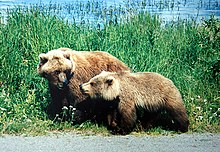
The wildlife of Alaska is abundant, extremely diverse and includes for case polar bears, puffins, moose, baldheaded eagles, Chill foxes, wolves, Canadian lynx, muskox, snowshoe hare, mountain goats, walrus and caribou. Life zones in Alaska range from grasslands, mountains, tundra to thick forests, which leads to a huge diverseness in terrain and geology throughout the country.
Alaska has also over 430 species of birds and the largest population of bald eagles in the nation. From pygmy shrews that weigh less than a penny to gray whales that weigh 45 tons, Alaska is the "Terminal Borderland" for animals equally well as people. Many species endangered elsewhere are still abundant in Alaska.
Aleutian Islands [edit]
The Aleutian Islands are home to an abundance of large bird colonies; more than than 240 bird species inhabit in Alaska'due south Aleutian Archipelago.[xix] Large seabird colonies are present on islands like Buldir Isle, which has 21 breeding seabird species, including the Bering Bounding main-endemic cerise-legged kittiwake.[20] Large seabird colonies are also present on Kiska Island, Gareloi Island, Semisopochnoi Island, Bogoslof Island, and several others.[21]
The islands are too frequented by vagrant Asiatic birds, including the common rosefinch, Siberian rubythroat, bluethroat, lanceolated warbler, and the start North American record of the intermediate egret. Other animals in the Aleutian Chain include the Chill fox, American mink, Porcupine caribou, northern sea otter, horned puffin, tufted puffin, Steller ocean lion, spotted seal, ringed seal, northern fur seal and many more.[21]
Territories [edit]
American Samoa [edit]

Because of its remote location, variety among the terrestrial species is low. The archipelago has a huge multifariousness in animals and more than 9,000 acres is a national park: National Park of American Samoa. The park stretches over three of the six islands in the archipelago: Tutuila, Ofu-Olosega and Ta'ū. Eight mammal species have been recorded at American Samoa, of which none of them are critically endangered.[a]
The mammals include several species of native bats, including the Samoa flying fox and insular flying fox. The avifauna includes 65 species of bird[22] where the more unusual distinctive ones are the blue-crowned lorikeet, the spotless crake, the many-colored fruit dove, the wattled honeyeater, tropical pigeons, the samoan starling, white tern, black noddy and the reddish-tailed tropicbird.[23]
There are many reptiles in the islands, including five species of geckos, eight species of skinks and two species of snakes: the Pacific boa and the Australoasian blindsnake.[24] The marine life is magnificent and much full-bodied effectually the colorful coral reefs. The Samoan ocean is a habitation to body of water turtles equally hawksbill sea turtle, olive ridley sea turtle, leatherback ocean turtle and the green bounding main turtle. V species of dolphins alive in the surface area: spinner dolphin, crude-toothed dolphin, bottlenose dolphin, pantropical spotted dolphin and striped dolphin.[24]
Guam [edit]
Shortly subsequently Globe War 2, the brown tree snake was introduced to the isle of Guam and acquired much of the endemic wild animals to go extinct. Due to an abundance of casualty species and lack of predators, the brown tree snake'southward population exploded and reached nearly thirteen,000 snakes per foursquare mile at nearly.[25] Ten out of twelve endemic bird species, ten lizards and two bats all became extinct equally a result of the introduction of the brown tree ophidian. In contempo years, a lot has been done by the U.South. government to decrease the number of brown tree snakes on the island. For case in 2013, a $ane one thousand thousand program by the U.Due south. Fish and Wildlife Service dropped more than 2000 mice filled with poison on the island.[26] In 2013, more than two million brown tree snakes were estimated to be on the island.[26] Other introduced species include the Philippine deer, the Asiatic water buffalo, the marine toad and the giant African land snail.[25] Several native species of skinks, geckos and monitor lizards are still found on the island.
Northern Mariana Islands [edit]
The Commonwealth of Northern Mariana Islands is abode to 40 indigenous and introduced bird species. Some endemic bird species are the Mariana fruit dove, the Mariana swiftlet, the Rota white-eye, the Tinian monarch, the bridled white-eye and the gold white-centre. Other mutual, but introduced species, include the collared kingfisher, the rufous fantail, the fairy tern and the uniform swiftlet. The Mariana fruit bat is endemic to both Guam and the Northern Mariana Islands. The sambar deer is the largest mammal and lives on several of the islands. The monitor lizard, ranging upward to 3 feet long, is too present on the island of Rota. The oceans are home to more than than a thousand species of marine life,[27] including for case the coconut crabs, the mahi-mahi, the barracuda, tridacna, marlin and tuna.
Puerto Rico [edit]

The Mona ground iguana is the largest native terrestrial lizard in Puerto Rico and is an endangered species.
Puerto Rico has 349 bird species, 83 mammals, 25 amphibians, 61 reptiles and 677 species of fish. Birds institute nowhere else on earth include for instance the Puerto Rican owl, the Puerto Rican woodpecker, the Puerto Rican tody, the green mango, the Puerto Rican emerald, the Puerto Rican lizard cuckoo, the Puerto Rican nightjar and many more. All electric current endemic xiii land mammals are bats, which includes for instance the greater bulldog bat, the Antillean ghost-faced bat and the Parnell'southward mustached bat. Extinct native mammals include the plate-toothed giant hutia and the Puerto Rican cavern rat. Reptiles unique to Puerto Rico include the Puerto Rican boa, the guanica blindsnake, the Mona Isle iguana, the Puerto Rican worm lizard, the Puerto Rican galliwasp and the Nichols' dwarf gecko. Amphibians native to the island include the Puerto Rican crested toad, the common coqui, the locust coqui, the wrinkled coqui, the woods coqui, the elfin coqui and the statuary coqui. Endemic fish include the Puerto Rican snake eel and the Puerto Rico coralbrotula.[28]
Virgin Islands [edit]
The Virgin Islands National Park covers approximately 60% of the Island of St. John and nearly all of Hassel Isle. The national park has more than than 140 species of birds, 302 species of fish, 7 species of amphibians and 22 species of mammals.[29] The tropical Virgin Islands are dwelling house to a huge variety of wild fauna, including many unique species endemic to the archipelago. There are three species of bounding main turtles in the USVI that inhabit the local waters and employ beaches for nesting: the green sea turtle, the hawksbill sea turtle and the leatherback body of water turtle.[thirty] Several species of sharks, manatees and dolphins roam the seas.
Manufactures past surface area [edit]
Run into besides [edit]
- Fauna welfare in the United States
- Flora of the United States
- Invasive species in the United States
Notes [edit]
- ^ This list is derived from the IUCN Red Listing which lists species of mammals and includes those mammals that take recently been classified as extinct (since 1500 Advert). The taxonomy and naming of the private species is based on those used in existing Wikipedia articles as of 21 May 2007 and supplemented past the common names and taxonomy from the IUCN, Smithsonian Institution, or University of Michigan where no Wikipedia commodity was available.
References [edit]
- ^ "United States | History, Map, Flag, & Population". Encyclopedia Britannica.
- ^ "Birds". Audubon.
- ^ "PlanAndPlant.com is for sale". HugeDomains. Archived from the original on April 14, 2013.
- ^ "Number of Native Species in United States - Electric current Results". www.currentresults.com.
- ^ "NPS.gov Homepage (U.S. National Park Service)". world wide web.nps.gov.
- ^ "Yellowstone Fact Sheet - Yellowstone National Park". Archived from the original on June 2, 2013.
- ^ Rattlesnake facts
- ^ C. Michael Hogan. 2008. Torrey Pine: Pinus torreyana, Globaltwitcher, ed. Nicklas Stromberg [1] Archived 2012-05-25 at the Wayback Motorcar
- ^ Carwardine, Mark (2008). Animal Records. New York: Sterling. p. 11. ISBN9781402756238.
- ^ a b "American Bison | National Geographic". Animals. May 10, 2011.
- ^ a b c d east Whitaker, John O. and William John Hamilton. 1998. Mammals of the Eastern United States. Ithaca, NY: Cornell Academy Press. ISBN 9780801434754.
- ^ a b c d e Feldhamer, George A., Bruce C. Thompson and Joseph A. Chapman. 2003. Wild Mammals of North America: Biology, Management, and Conservation. Baltimore, Md: JHU Printing. ISBN 9780801874161.
- ^ "Northeast Region, U.Southward. Fish and Wildlife Service". www.fws.gov.
- ^ "USFWS: Extinct Species". www.fws.gov.
- ^ Helgen, Chiliad.; Turvey, S.T. (2016). "Neovison macrodon". IUCN Scarlet Listing of Threatened Species. 2016: e.T40784A45204492. doi:10.2305/IUCN.UK.2016-1.RLTS.T40784A45204492.en . Retrieved fifteen January 2020.
- ^ a b "Hawaii beast - the Hawaiian animals". world wide web.to-hawaii.com.
- ^ Turtles in the Hawaiian Islands
- ^ "Purchase Cheap Essay from the Affordable Writing Service Online". www.buy-cheapessay.com.
- ^ "Travel Alaska - Southwest Alaska - the Aleutian Islands".
- ^ [2] [ dead link ]
- ^ a b "Campaign". Oceana.
- ^ Watling, Dick (2001) A Guide to the Birds of Republic of the fiji islands & Western Polynesia, Environmental Consultants (Fiji), Suva
- ^ "Marine & Wildlife Topics" (PDF) . Retrieved 2021-05-11 .
- ^ a b "List" (PDF). world wide web.nps.gov. Retrieved 2021-05-eleven .
- ^ a b "Archived copy". Archived from the original on 2013-xi-eleven. Retrieved 2013-07-10 .
{{cite web}}: CS1 maint: archived copy as title (link) - ^ a b Brad Lendon (February 28, 2013). "Mortiferous mice to rain down on Guam snakes". CNN.
- ^ Podróże - Kobieta.pl [ dead link ]
- ^ "Animals and Plants Unique to Puerto Rico". lntreasures.com.
- ^ John, Mailing Accost: 1300 Cruz Bay Creek St; Us, Six 00830 Phone:776-6201 x238 Headquarters/Visitor Center telephone contact Information Contact. "Animals - Virgin Islands National Park (U.Southward. National Park Service)". world wide web.nps.gov.
- ^ "Sea Turtles of the U.Southward. Virgin Islands". Archived from the original on April 9, 2013.
Source: https://en.wikipedia.org/wiki/Fauna_of_the_United_States
Posted by: coopertherof.blogspot.com

0 Response to "What Is The Largest Land Animal In The Western Hemisphere Is The What? |quizlet"
Post a Comment